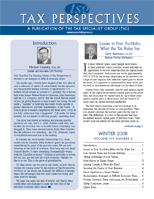
PDF Format
 Issue Contents Issue Contents
 All Issues All Issues
Winter 2008
Volume 8, Number 2
The information in Tax Perspectives is prepared for general interest only. Every effort has been made to ensure that the contents are accurate. However, professional advice should always be obtained before acting and TSG member firms cannot assume any liability for persons who act on the basis of information contained herein without professional advice.
Foreign Currency Gains and Losses, the Technicalities
By Michael Cadesky, FCA, TEP
Cadesky and Associates LLP (Toronto)
Not surprisingly, the Canadian tax system is “denominated” in Canadian dollars. This means that income (and loss) and capital gains (and losses) are to be calculated in Canadian currency using exchange rates appropriate for the transactions that have given rise to them.
Many Canadians consider U.S. dollars a reference currency. If the Canadian dollar falls against the U.S. dollar, there is an economic loss because Canadians lose purchasing power. If the Canadian dollar appreciates against the U.S. dollar, there is an economic gain. However, for tax purposes, the reverse is true.
Suppose that, when the Canadian dollar was at 70¢ to the U.S. dollar, an individual converted Cdn $100,000 to U.S. dollars, and placed it in a savings account; when the Canadian dollar appreciated to parity, the U.S.$70,000 was converted to Canadian currency. The Canadian equivalent would be $70,000, resulting in a loss of $30,000. Alternatively, suppose that when the Canadian dollar reached parity with the U.S. dollar, Cdn $100,000 was deposited in the U.S. dollar account; when the Canadian dollar declined this year to U.S.$0.80, the funds (U.S.$100,000) were converted back. This would result in a gain of $25,000.
In these examples, the loss would be a capital loss, and the gain would be a capital gain.
This seems simple, but suppose the funds were invested in say a U.S. treasury bill that matured? Suppose the funds would be reinvested in a second U.S. treasury bill, not converted back to Canadian dollars. In this circumstance, a gain or loss would result from foreign currency translation, because the new U.S. treasury bill is considered a new investment, to be computed in Canadian currency, resulting in a gain or loss from foreign currency conversion at that time. While this may not seem to be intuitively obvious, the rules concerning foreign currency conversion mandate this treatment.
In our experience, this is frequently overlooked. Generally, when trading stocks, investors deal well with foreign currency conversion, but frequently ignore it when dealing with foreign bank accounts, treasury bills, and even bonds.
Because of the major fluctuations in the value of Canadian currency this year, many clients may have capital gains from U.S. currency conversion. Although not intuitive, this is the unfortunate result of a decline in the value of the Canadian dollar!
|